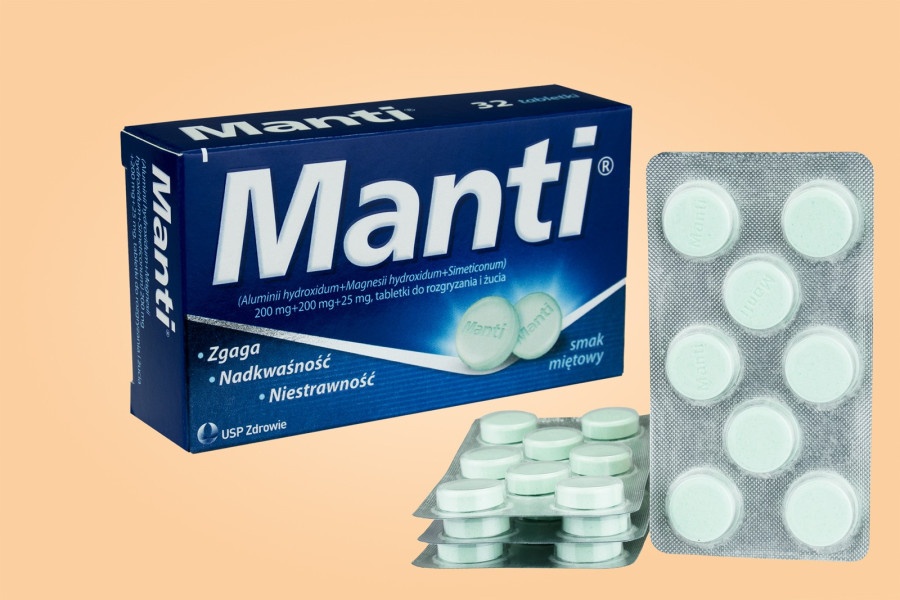

Manti

Ask a doctor about a prescription for Manti

How to use Manti
Leaflet attached to the packaging: patient information
Manti
200 mg + 200 mg + 25 mg, chewable tablets
(Aluminum hydroxide + Magnesium hydroxide + Simethicone)
You should carefully read the contents of the leaflet before taking the medicine, as it contains important information for the patient.
This medicine should always be taken exactly as described in this patient leaflet or as directed by your doctor or pharmacist.
- You should keep this leaflet, so you can read it again if you need to.
- If you need advice or additional information, you should consult a pharmacist.
- If you experience any side effects, including those not listed in the leaflet, you should tell your doctor or pharmacist. See section 4.
- If you do not feel better or feel worse after a few days, you should contact your doctor.
Table of contents of the leaflet
1. What is Manti and what is it used for
2. Important information before taking Manti
3. How to take Manti
4. Possible side effects
5. How to store Manti
6. Contents of the packaging and other information
1. What is Manti and what is it used for
Manti contains the active substances: aluminum hydroxide, magnesium hydroxide, and simethicone.
Aluminum and magnesium hydroxide neutralize stomach acid. As a result of this reaction, the acidity of the stomach juice decreases, which limits its damaging effect on the stomach mucosa.
The simethicone contained in the preparation reduces discomfort associated with the accumulation of excessive gas in the digestive tract.
The indications for the use of Manti include: symptomatic treatment of heartburn and bloating and abdominal pain caused by excessive gas production in the intestines, accompanying disorders of the upper digestive tract: gastric ulcer or duodenal ulcer, gastritis, hyperacidity, esophageal reflux, dyspepsia, and other stomach and intestinal disorders.
The onset of therapeutic action in the form of acid neutralization occurs quickly, within 10 to 15 minutes after taking the preparation. Similarly, rapid relief of pain was observed in patients with heartburn.
2. Important information before taking Manti
When not to take Manti:
- if you are allergic to the active substances or any of the other ingredients of the medicine (listed in section 6),
- in severe kidney failure, especially those treated with dialysis,
- in patients with phenylketonuria due to the presence of aspartame,
- in patients with intolerance to certain sugars, due to the presence of sorbitol.
Warnings and precautions
Before starting to take Manti, you should inform your doctor or pharmacist about taking non-steroidal anti-inflammatory drugs, as antacids may mask the symptoms of gastrointestinal bleeding.
Long-term use of Manti with insufficient phosphate intake may lead to phosphate deficiency (hypophosphatemia) and kidney failure due to the deposition of ammonium magnesium phosphate.
Children
Manti should not be taken by children under 6 years of age.
Manti and other medicines
Antacids may change the absorption of many medicines. To avoid interactions, you should maintain at least a 2-hour interval between taking Manti and other oral medicines.
You should inform your doctor or pharmacist about all medicines you are currently taking or have recently taken, as well as any medicines you plan to take.
As a result of the decrease in stomach acidity, Manti may affect the solubility, absorption, bioavailability, and excretion of some medicines taken at the same time.
Manti may reduce the absorption of:antibiotics, including tetracyclines, macrolide antibiotics (azithromycin), antiprotozoal and antibacterial agents (metronidazole), fluoroquinolones (ciprofloxacin, ofloxacin), medicines used in hypertension (angiotensin-converting enzyme inhibitors), beta-blockers (atenolol, propranolol), sedatives and hypnotics (benzodiazepine derivatives and phenothiazine neuroleptics), medicines used in gastric ulcer (H2 receptor antagonists), iron preparations, antifungal agents (ketoconazole), anti-tuberculosis agents (isoniazid), glucocorticosteroids (e.g., cortisol, cortisone, corticosterone), salicylates (e.g., acetylsalicylic acid), medicines used in heart failure and atrial fibrillation (digoxin), medicines used in epilepsy (phenytoin), medicines used in hypothyroidism (levothyroxine).
Manti may increase the absorption of:oral anti-diabetic drugs from the sulfonylurea group (glipizide, glibenclamide, chlorpropamide, tolbutamide), medicines that reduce blood clotting (coumarin derivatives), antibiotics (amoxicillin), medicines used in coronary heart disease and hypertension (nifedipine), medicines used in cerebrovascular disorders (pentoxifylline), medicines used in rhinitis and sinusitis (pseudoephedrine).
Taking Manti with food, drink, and alcohol
Taking the medicine immediately after a meal may prolong its action.
Pregnancy, breastfeeding, and fertility
The use of Manti by pregnant women requires absolute consultation with a doctor and is possible only when the benefits outweigh the risks.
The use of Manti during breastfeeding is not recommended, as it is not known whether antacids pass into breast milk.
The effect of aluminum hydroxide, magnesium hydroxide, and simethicone on fertility in humans is not known.
Driving and using machines
Taking Manti does not affect driving or operating machinery.
Manti contains aspartame, sorbitol, glucose (derived from maltodextrin), and sodium:
The medicine contains 6.3 mg of aspartame in one tablet. Aspartame is a source of phenylalanine. It may be harmful to patients with phenylketonuria. This is a rare genetic disorder in which phenylalanine accumulates in the body due to its improper excretion.
The medicine contains a maximum of 703.6 mg of sorbitol (E 420) in one tablet. Sorbitol is a source of fructose. If you have previously been diagnosed with intolerance to certain sugars or have been diagnosed with hereditary fructose intolerance, a rare genetic disorder in which the body does not break down fructose, you should consult your doctor before taking the medicine or giving it to your child. Sorbitol may cause gastrointestinal discomfort and may have a mild laxative effect.
The medicine contains glucose derived from maltodextrin. If you have previously been diagnosed with intolerance to certain sugars, you should consult your doctor before taking the medicine.
The medicine contains less than 1 mmol (23 mg) of sodium in one tablet, which means the medicine is considered "sodium-free".
3. How to take Manti
This medicine should always be taken exactly as described in the patient leaflet or as directed by your pharmacist. If you have any doubts, you should consult your doctor or pharmacist.
Adults and children over 6 years of age:
The recommended dose is 1 to 3 tablets between meals, before bedtime, and when stomach discomfort occurs.
Do not swallow the tablets whole. Do not take more than the recommended daily dose of 12 tablets.
Do not take the maximum doses for more than 2 weeks.
Taking a higher dose of Manti than recommended
In the event of a single significant overdose, the aluminum hydroxide, magnesium hydroxide, and simethicone contained in the medicine do not pose a significant toxicological risk due to their minimal absorption rate. However, nausea and gastrointestinal disorders may occur.
If you have taken more than the recommended dose of the medicine, you should immediately consult your doctor or pharmacist.
Missing a dose of Manti
If you miss a dose, you should take the next dose. Do not take a double dose to make up for the missed dose.
Stopping treatment with Manti
If you have any further doubts about taking this medicine, you should consult your doctor or pharmacist.
4. Possible side effects
Like all medicines, Manti can cause side effects, although not everybody gets them.
In most cases, Manti is well tolerated, but like other medicines, it may cause the following side effects, especially with long-term use:
Uncommon side effects (may occur in less than 1 in 100 people)
- diarrhea, constipation, bloating, excessive gas,
Frequency not known (cannot be estimated from the available data)
- immune system disorders: hypersensitivity reactions, such as itching, hives, angioedema, and anaphylactic reactions;
- metabolic and nutritional disorders: electrolyte imbalance: hypophosphatemia (decreased phosphate levels in the blood), hypocalcemia (decreased total calcium levels in the blood), hypercalciuria (increased calcium excretion in the urine), hypermagnesemia (elevated magnesium levels in the blood) in patients with kidney failure;
- psychiatric disorders: dementia (decreased activity, memory disorders) during long-term use in patients with kidney failure, especially those on dialysis;
- nervous system disorders: encephalopathy (brain damage, resulting in behavioral disorders) during long-term use in patients with kidney failure, especially those on dialysis;
- musculoskeletal and connective tissue disorders: osteomalacia (insufficient mineralization, resulting in the loss of calcium and phosphorus from bone tissue) and osteodystrophy (disorder of bone remodeling and mineralization) in patients taking high doses of the medicine for a long time.
Reporting side effects
If you experience any side effects, including those not listed in the leaflet, you should consult your doctor or pharmacist.
Side effects can be reported directly to the Department of Monitoring of Adverse Reactions to Medicinal Products, Medical Devices, and Biocidal Products,
Al. Jerozolimskie 181C,
02-222 Warsaw,
phone: +48 22 49 21 301,
fax: +48 22 49 21 309,
website: https://smz.ezdrowie.gov.pl
Side effects can also be reported to the marketing authorization holder.
Reporting side effects will allow for more information to be collected on the safety of the medicine.
5. How to store Manti
The medicine should be stored at a temperature below 25°C.
Store in a place out of sight and reach of children.
Do not use Manti after the expiration date stated on the carton and blister pack. The expiration date is the last day of the given month.
The labeling used for the blister pack is: EXP - expiration date, Lot - batch number.
Medicines should not be disposed of via wastewater or household waste. You should ask your pharmacist how to dispose of medicines that are no longer needed. This will help protect the environment.
6. Contents of the packaging and other information
What Manti contains
The active substances of the medicine are: aluminum hydroxide 200 mg, magnesium hydroxide 200 mg, simethicone 25 mg.
The excipients are: magnesium stearate, stearic acid, aspartame (E 951), blue dye (FD&C Blue No 1) (E 133), yellow dye (FD&C Yellow 10) (E 104), peppermint flavor SD 297, sodium croscarmellose, sorbitol (E 420), maltodextrin (contains glucose).
What Manti looks like and what the pack contains
The tablet is light green in color with visible white and darker spots, round, flat on both sides, with beveled edges, with a slightly minty smell, with the inscription "MANTI" embossed on one side.
The medicine is available in packs of: 2, 4, 6, 8, 10, 16, 20, 30, or 32 tablets, packaged in blisters and a carton with a leaflet. Not all pack sizes may be marketed.
Marketing authorization holder and manufacturer
US Pharmacia Sp. z o.o., ul. Ziębicka 40, 50-507 Wrocław
To obtain more detailed information, you should contact:
USP Zdrowie Sp. z o.o., ul. Poleczki 35, 02-822 Warsaw, phone +48 (22) 543 60 00.
Date of last revision of the leaflet:
- Country of registration
- Active substance
- Prescription requiredNo
- Manufacturer
- ImporterUS Pharmacia Sp. z o.o.
- This information is for reference only and does not constitute medical advice. Always consult a licensed doctor before taking any medication. Oladoctor is not responsible for medical decisions based on this content.
- Alternatives to MantiDosage form: Tablets, 340 mgActive substance: dihydroxialumini sodium carbonateManufacturer: Coripharma ehf. SENSILAB Polska Spółka z ograniczoną odpowiedzialnością - Spółka komandytowo-akcyjnaPrescription not requiredDosage form: Suspension, 1.02 g/15 mlActive substance: dihydroxialumini sodium carbonatePrescription not requiredDosage form: Tablets, 450 mg + 300 mgActive substance: ordinary salt combinationsManufacturer: Teva Operations Polska Sp. z o.o.Prescription not required
Alternatives to Manti in other countries
The best alternatives with the same active ingredient and therapeutic effect.
Alternative to Manti in Ukraine
Online doctors for Manti
Discuss dosage, side effects, interactions, contraindications, and prescription renewal for Manti – subject to medical assessment and local rules.











